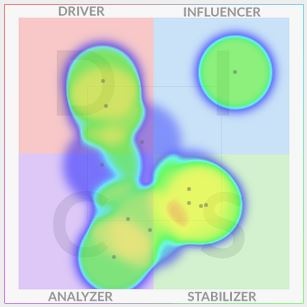ORG's exclusive “Heat Mapping” technology provides feedback to teams and organizations regarding their preferences and sets the groundwork for excellent coaching and change management conversations.
Here are examples of DISC Heat Map graphical depictions of two different teams.
One is of a well-rounded team that has balanced number of DISC types (Driver, Influencer, Stabilizer, Conscientious).

The other example shows a team with a predominant “S” (Stabilizer) personality type.
.jpg)
Each member of your team is represented by a dot. Based on the scores in all four DISC quadrants, the dot will be placed closer to the outer or inner corners of each quadrant. The closer your dot is to the outer edge of the quadrants, the more intense your core energy is in that style.
The color around your dot on the Team Graph is based on two things: an individual intensity in a core energy and the intensity of the team as a whole in a specific core energy. “Cool” colors indicate a lower team or individual intensities, while “warm” colors indicate higher team or individual intensities. As team member core energies overlap, that quadrant’s energies combine and intensify from yellow to red to represent that your team may exhibit more of these qualities than other areas.
Why is this important?
In increasingly virtual or remote environments, it is increasing difficult to “get to know” the people we are working with. Communication in the last 10 years has dramatically shifted to and abundance of short text-only communication which is leaving out important social/visual cues and reducing the amount of time we spend getting to know people. In an effort to better understand the people that we work, the DISC personality profile can be very effective in helping teams understand what style of communication members of our team or meeting prefer.
For leaders, looking at a larger slice of an organization and seeing its core energy concentrations can help form strategy that allows management to better communicate plans to team members with the kind of messaging that the team members are expecting.
At the heart of this information is an insight into the “personality” of a group of people. To an informed eye knowing the dominant types of core energies in a meeting, team or region can help inform the best ways to communicate with and facilitate communication in this group of individuals.

